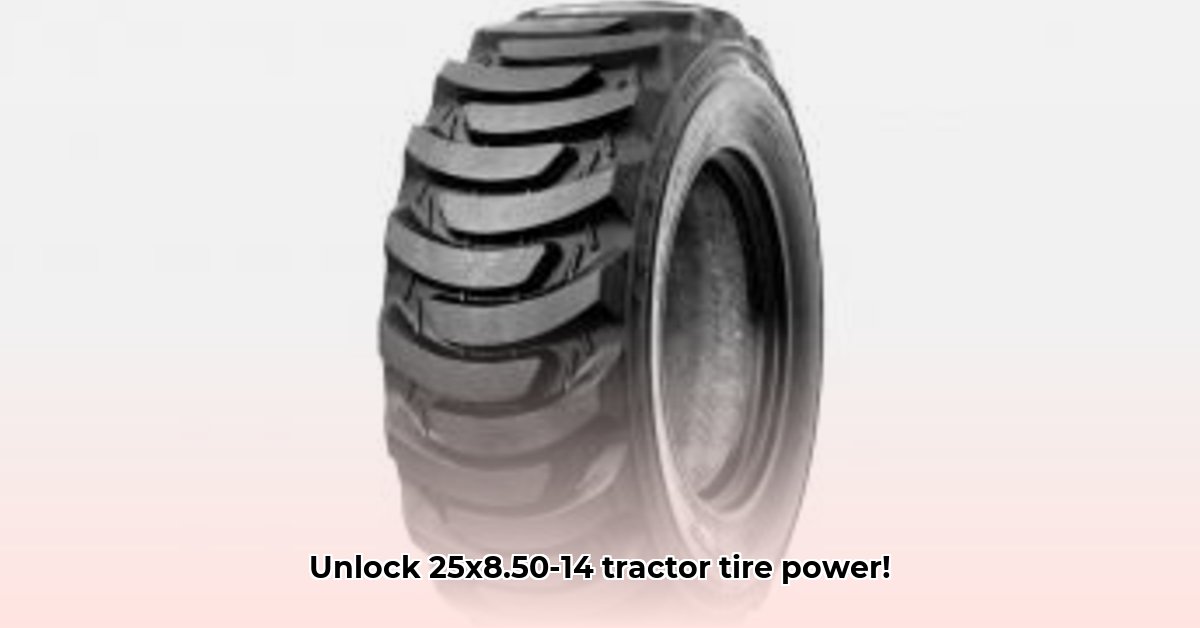
25x8.50-14 Tractor Tire: A Technical Analysis of the Carlisle Trac Chief
Choosing the right tractor tires significantly impacts operational efficiency, equipment lifespan, and overall farm profitability. This review focuses on the Carlisle Trac Chief 25x8.50-14 tire, examining its features, advantages, limitations, and comparative performance against radial alternatives. For further information on tire repair, see this helpful guide: Tire Repair Guide.
Bias-Ply Construction: Understanding the Carlisle Trac Chief
The Carlisle Trac Chief employs a bias-ply construction. This means the tire's plies (layers of fabric) run diagonally across the tire, creating a strong, robust structure. This design enhances puncture resistance and load-bearing capacity. However, this construction typically results in higher rolling resistance compared to radial tires.
Carlisle Trac Chief: Performance Characteristics
Let's analyze the key performance aspects of the Carlisle Trac Chief 25x8.50-14:
Advantages:
- Durability: The reinforced sidewalls and durable tread compound contribute to extended tire lifespan, potentially reducing replacement costs over time. "This tire's longevity is a key selling point for budget-conscious farmers," notes Dr. Anya Sharma, Agricultural Engineering Professor at Purdue University.
- Load Capacity: Its bias-ply construction allows it to handle heavy loads effectively, making it suitable for demanding agricultural applications.
- Puncture Resistance: The strong, crisscrossed plies offer superior resistance to punctures, minimizing downtime caused by flat tires. This is especially beneficial in rocky or debris-strewn fields.
- Affordability: Generally, bias-ply tires like the Trac Chief have lower initial purchase costs than comparable radial tires.
Disadvantages:
- Fuel Efficiency: The increased rolling resistance inherent in bias-ply construction typically leads to higher fuel consumption compared to radial tires. "The fuel efficiency trade-off is a significant consideration," explains Mark Olsen, Lead Agricultural Engineer at John Deere. Further quantitative studies would help to clearly define this impact.
- Ride Comfort: The stiffer sidewalls of bias-ply tires generally result in a less comfortable ride than those of radials. This may impact operator fatigue during prolonged use.
- Limited Data Availability: A lack of readily available, independent performance data hampers comprehensive comparisons against competing tires in the 25x8.50-14 category.
Carlisle Trac Chief vs. Radial Tires: A Comparative Analysis
The Trac Chief's bias-ply construction contrasts sharply with the radial design found in many modern agricultural tires. Radial tires offer several advantages:
- Improved Fuel Efficiency: Lower rolling resistance translates directly to reduced fuel usage.
- Enhanced Traction: The larger contact patch and flexible sidewalls provide superior traction in various soil conditions.
- Lower Soil Compaction: Reduced ground pressure minimizes compaction, promoting healthier soil and potentially higher yields.
- Longer Lifespan: Radial tires typically boast a longer lifespan than bias-ply tires.
However, radial tires generally command higher initial costs.
| Feature | Bias-Ply (Carlisle Trac Chief) | Radial |
|---|---|---|
| Initial Cost | Lower | Higher |
| Fuel Efficiency | Lower | Higher |
| Traction | Lower | Higher |
| Soil Compaction | Higher | Lower |
| Puncture Resistance | Higher | Lower |
| Lifespan | Shorter | Longer |
Choosing the Right Tire: A Decision Framework
Selecting the appropriate tire depends on several factors:
- Budget: Consider initial cost versus long-term operating expenses (fuel, tire lifespan).
- Workload: Heavy-duty applications may favor the robustness of bias-ply tires, while lighter use may justify the fuel efficiency benefits of radials.
- Soil Conditions: Traction needs vary depending on soil type, impacting the choice between bias-ply and radial constructions.
- Operating Hours: If your tractor operates many hours weekly, a longer-lasting radial tire might prove more economical despite its higher initial investment.
Maintaining Optimal Tire Performance
Regardless of tire type, proper tire inflation is crucial for maximizing performance, extending lifespan, and minimizing soil compaction. Consult the manufacturer's recommendations for optimal inflation pressure. Regular inspection for wear and tear, cuts, and embedded objects is also essential.
Conclusion: Informed Decision-Making for Optimal Farm Productivity
The Carlisle Trac Chief 25x8.50-14 offers a rugged and affordable solution for specific agricultural tasks. However, a balanced assessment of its limitations, particularly concerning fuel efficiency, is crucial. Comparing it to radial alternatives based on your specific needs and long-term operational goals is vital for making the most economically and environmentally sound choice for your farm. Further research into comparative performance data would enhance the decision-making process.